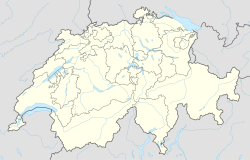Giebenach
| Giebenach | ||
|---|---|---|
|
||
| Coordinates: 47°31′N 7°45′E / 47.517°N 7.750°ECoordinates: 47°31′N 7°45′E / 47.517°N 7.750°E | ||
| Country | Switzerland | |
| Canton | Basel-Landschaft | |
| District | Liestal | |
| Area | ||
| • Total | 1.34 km2 (0.52 sq mi) | |
| Elevation | 319 m (1,047 ft) | |
| Population (Mar 2016) | ||
| • Total | 1,038 | |
| • Density | 770/km2 (2,000/sq mi) | |
| Postal code | 4304 | |
| SFOS number | 2826 | |
| Surrounded by | Arisdorf, Augst, Füllinsdorf, Kaiseraugst (AG), Olsberg (AG) | |
| Website |
www SFSO statistics |
|
Giebenach is a municipality in the district of Liestal in the canton of Basel-Country in Switzerland.
Giebenach is first mentioned in 1246 as in villa Gibenacho.
Giebenach has an area, as of 2009[update], of 1.34 square kilometers (0.52 sq mi). Of this area, 0.77 km2 (0.30 sq mi) or 57.5% is used for agricultural purposes, while 0.24 km2 (0.093 sq mi) or 17.9% is forested. Of the rest of the land, 0.33 km2 (0.13 sq mi) or 24.6% is settled (buildings or roads).
Of the built up area, housing and buildings made up 14.9% and transportation infrastructure made up 7.5%. Out of the forested land, 16.4% of the total land area is heavily forested and 1.5% is covered with orchards or small clusters of trees. Of the agricultural land, 44.8% is used for growing crops and 10.4% is pastures, while 2.2% is used for orchards or vine crops.
The municipality is located in the Liestal district, at the confluence of the Violen and Arisdorfer streams to the south-east of Augst. It consists of the haufendorf village (an irregular, unplanned and quite closely packed village, built around a central square) of Giebenach.
The blazon of the municipal coat of arms is Azure, a Pentagram Argent.
Giebenach has a population (as of March 2016[update]) of 1,038. As of 2008[update], 18.3% of the population are resident foreign nationals. Over the last 10 years (1997–2007) the population has changed at a rate of 29.6%.
Most of the population (as of 2000[update]) speaks German (738 or 92.5%), with Italian language being second most common (18 or 2.3%) and French being third (10 or 1.3%).
...
Wikipedia




